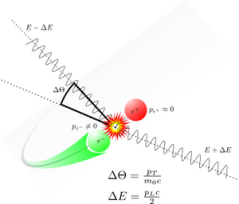MLZ ist eine Kooperation aus:
 > Technische Universität München
> Technische Universität München > Helmholtz-Zentrum Hereon
> Helmholtz-Zentrum Hereon
 > Forschungszentrum Jülich
> Forschungszentrum Jülich
MLZ ist Mitglied in:
 > LENS
> LENS > ERF-AISBL
> ERF-AISBL
MLZ in den sozialen Medien:

MLZ
Lichtenbergstr.1
85748 Garching
Untersuchungen von elektronischen Strukturen
Positron Annihilation and Electron Momentum
When a positron is implanted in a sample and annihilates with an electron, the momentum is a conserved quantity. The sum of the momenta of the emitted gamma quanta is therefore essentially equal to the momentum of the annihilated electron, as the positron carries only a thermal momentum.In the overwhelming majority of cases the annihilation happens via the emission of two gamma quanta, each of around 511 keV energy.
A non-zero electron momentum therefore manifests itself in deviations of the energies of the emitted quanta from the mean value (corresponding to the longitudinal component and studied by Doppler Broadening – or Coincident Doppler Broadening Spectroscopy) or deviations from anti-parallel emission directions (corresponding to the transversal momentum component) on the order of a few mrad.
Probing the Fermi Surface with Positrons
Measurements exploiting the angular deviation are called Angular Correlation of Positron Annihilation Radiation (ACAR). As only two of the three electron momentum components can be measured, the experiment gives a two-dimensional projection of the electron density in reciprocal space. By recording spectra for different orientations of a single-crystalline sample, however, eventually the complete three-dimensional electron momentum density can be computationally reconstructed. In the most idealized picture, this momentum density has regions of higher and of lower density, separated by sharp breaks, which correspond directly to the Fermi surface separating occupied from unoccupied regions within a band. Additionally, the method is sensitive to effects of the positron wavefunction and to correlations between the positron and the electrons or electron many-body effects.Leiter der Forschungsgruppe
Prof. Dr. Christoph Hugenschmidt
Telefon: +49 (0)89 289-14609
E-Mail: christoph.hugenschmidt@frm2.tum.de
Physik mit Positronen
> Home
> Aktuelles
> Team
> Forschung:
- Positronenstrahlen
- Defektspektroskopie
- Freie Volumina
- Elektronische Struktur
- Oberflächenphysik
- Grundlagenforschung
> Publikationen & Präsentationen
> Lehre
> Galerie
> Funding
> Nützliche Links
MLZ ist eine Kooperation aus:
 > Technische Universität München
> Technische Universität München > Helmholtz-Zentrum Hereon
> Helmholtz-Zentrum Hereon
 > Forschungszentrum Jülich
> Forschungszentrum Jülich
MLZ ist Mitglied in:
 > LENS
> LENS > ERF-AISBL
> ERF-AISBL
MLZ in den sozialen Medien:



